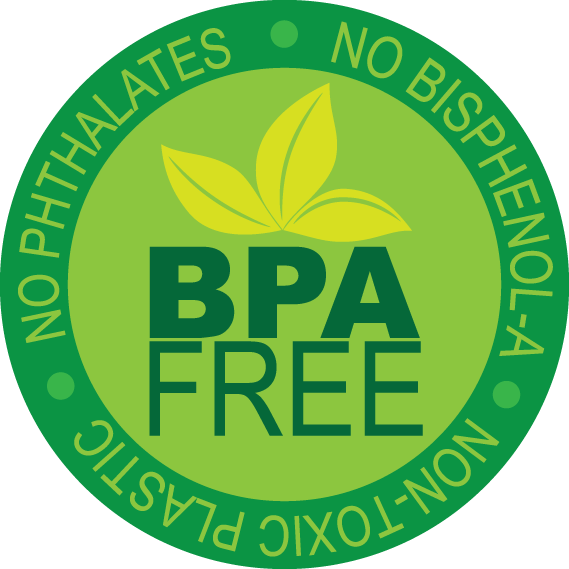By Ladd McNamara, M.D.
 Plastics pose a health risk due to Bisphenol A (BPA) and phthalates (pronounced “THAL-ates”), which leach into our food and beverages, particularly when heated. The Centers for Disease Control and Prevention (CDC) found BPA in the urine of 93% of people tested. That means that you and I most likely have BPA and phthalates coursing through our bodies nearly all the time.
Plastics pose a health risk due to Bisphenol A (BPA) and phthalates (pronounced “THAL-ates”), which leach into our food and beverages, particularly when heated. The Centers for Disease Control and Prevention (CDC) found BPA in the urine of 93% of people tested. That means that you and I most likely have BPA and phthalates coursing through our bodies nearly all the time.
BPA allows for strong, shatter-proof recyclable plastics as with eyeglass frames and lenses, medical devices, plastic food storage containers, plastic tableware, water bottles, sippy cups, and baby bottles. BPA is also found in the epoxy resins used to coat, or line metal products such as the inside of food cans, bottle tops, water supply pipes, and cashier receipts, among other items.
Phthalates make plastics soft and flexible, as with the nipple of a baby’s pacifier or bottle. Phthalates are found in medical devices like PVC, blood IV bags and tubing, vinyl flooring, vinyl wallpaper, and vinyl shower curtains, toys, car interiors, and some fragrances.
Possible Health Consequences
 Although BPA has not been shown to cause developmental problems in infants and children, BPA’s adverse effects have been seen among animal models. Therefore, caution is still very much warranted. Though the government suggests that BPAs are probably not harmful, there are studies that show there are associations between high urine BPA levels and health disorders. BPAs have been shown in the animal model to adversely affect reproductive hormones, as BPA is a hormone disruptor. Human studies suggest a possible effect of BPA on men who are exposed to high levels in the workplace.
Although BPA has not been shown to cause developmental problems in infants and children, BPA’s adverse effects have been seen among animal models. Therefore, caution is still very much warranted. Though the government suggests that BPAs are probably not harmful, there are studies that show there are associations between high urine BPA levels and health disorders. BPAs have been shown in the animal model to adversely affect reproductive hormones, as BPA is a hormone disruptor. Human studies suggest a possible effect of BPA on men who are exposed to high levels in the workplace.
As with BPA, phthalates are being detected in humans, but the degree that they are causing health problems is currently inconclusive. Therefore, we must rely on animal studies to give us insight as to how they may be affecting us.
Micronutrients reduce the risk of negative health consequences, which means the wisest among us would also implement an on-going quality nutritional supplement protocol into their lives.
Animal studies have demonstrated adverse effects from phthalates on the liver, kidney, and reproductive system, especially if exposure occurred during gestation. For example, animals exposed to phthalates during gestation were subsequently found to have early puberty in females, and decreased sperm activity and concentration, as well as testicular cancer in males.
Insulin Resistance, Diabetes, and Metabolic Syndrome
 Although genetics and our lifestyle habits play a large role in our risks for developing heart disease, stroke, and diabetes, the exposure to environmental toxins may increase those risks. There are concerns that BPA and phthalates may increase the risk of metabolic syndrome, which is a disorder that increases the risk for heart disease, stroke, diabetes, and obesity. Metabolic syndrome is a disorder made up of a grouping of five components–
Although genetics and our lifestyle habits play a large role in our risks for developing heart disease, stroke, and diabetes, the exposure to environmental toxins may increase those risks. There are concerns that BPA and phthalates may increase the risk of metabolic syndrome, which is a disorder that increases the risk for heart disease, stroke, diabetes, and obesity. Metabolic syndrome is a disorder made up of a grouping of five components–
- High Blood Pressure (> 130/85)
- Insulin Resistance (high blood sugar)
- Excess Abdominal Fat
- High Triglycerides (dyslipidemia)
- Low HDL Cholesterol
BPA and phthalates are hormone disruptors, and have been shown to increase the risk of insulin resistance and diabetes. Diabetes is associated with high blood pressure, obesity, and dyslipidemia. These chemicals have been shown to affect the insulin-producing cells of the pancreas, and they may also affect the insulin receptors on cell membranes. It also has slight estrogenic effects.
There are concerns that BPA and phthalates have negative effects on the brain, as there are associations with learning disabilities and autism spectrum disorders.
Regardless of the degree that BPA and phthalates affect our health, I think it would be wise to keep our exposure to BPA and phthalates at a minimum. In addition, it has been shown that micronutrients reduce the risk of negative health consequences, which means the wisest among us would also implement an on-going quality nutritional supplement protocol into their lives.
Minimize Your BPA and Phthalate Exposure
 Use glass or stainless-steel containers for food and beverages, particularly if hot.
Use glass or stainless-steel containers for food and beverages, particularly if hot.- Use BPA-Free plastics for all food and drinks.
- Avoiding plastic containers marked with a recycle rating of 1 or 7 pc. Instead, use plastics with a 2, 4, or 5 rating.
- Do not use plastic containers, plates, or cups in the microwave.
- Avoid perfumed shampoo and lotion, unless you trust the manufacturer to use non-toxic scents.
- Avoid giving vinyl toys to children.
- Do not use plastic bottles with your baby. Instead, use glass baby bottles.
- Don’t use latex bottle nipples unless rated as BPA and phthalate free. Consider silicone nipples.
- Take high-quality nutritional supplements on a daily basis; including grape seed extract.
References
- Stahlhut RW, et al. Experimental BPA Exposure and Glucose-Stimulated Insulin Response in Adult Men and Women. J Endocr Soc. 2018 Sep 12;2(10):1173-1187.
- Shoshtari-Yeganeh B, et al. Systematic review and meta-analysis on the association between phthalates exposure and insulin resistance. Environ Sci Pollut Res Int. 2019 Feb 8.
- Gaston SA, Tulve NS. Urinary phthalate metabolites and metabolic syndrome in U.S. adolescents: Cross-sectional results from the National Health and Nutrition Examination Survey (2003-2014) data. Int J Hyg Environ Health. 2018 Oct 5. pii: S1438-4639(18)30015-4.
- Konieczna A, et al. Serum bisphenol A concentrations correlate with serum testosterone levels in women with polycystic ovary syndrome. Reprod Toxicol. 2018 Dec;82:32-37.
- Lidia Caporossi L, Papaleo B. Bisphenol A and Metabolic Diseases: Challenges for Occupational Medicine. Int J Environ Res Public Health. 2017 Aug 25;14(9).
- Hong SH, et al. Urinary bisphenol A is associated with insulin resistance and obesity in reproductive-aged women. Clin Endocrinol (Oxf). 2017 Apr;86(4):506-512.
- Piecha R, et al. Urine Levels of Phthalate Metabolites and Bisphenol A in Relation to Main Metabolic Syndrome Components: Dyslipidemia, Hypertension and Type 2 Diabetes. A Pilot Study. Cent Eur J Public Health. 2016 Dec;24(4):297-301.
- Stein TP, et al. Bisphenol A Exposure in Children With Autism Spectrum Disorders. Autism Res. 2015 Jun;8(3):272-83.
- Preciados M, Yoo C, Roy D. Estrogenic Endocrine Disrupting Chemicals Influencing NRF1 Regulated Gene Networks in the Development of Complex Human Brain Diseases. Int J Mol Sci. 2016 Dec 13;17(12).




